Cayley graph
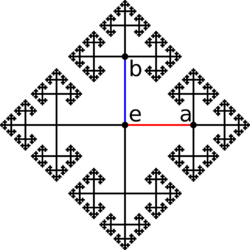
In mathematics, a Cayley graph, also known as a Cayley color graph, Cayley diagram, group diagram, or color group,[1] is a graph that encodes the abstract structure of a group. Its definition is suggested by Cayley's theorem (named after Arthur Cayley), and uses a specified set of generators for the group. It is a central tool in combinatorial and geometric group theory. The structure and symmetry of Cayley graphs makes them particularly good candidates for constructing expander graphs.
Definition
Let be a group and be a generating set of . The Cayley graph is an edge-colored directed graph constructed as follows:[2]
- Each element of is assigned a vertex: the vertex set of is identified with
- Each element of is assigned a color .
- For every and , there is a directed edge of color from the vertex corresponding to to the one corresponding to .
Not every convention requires that generate the group. If is not a generating set for , then is disconnected and each connected component represents a coset of the subgroup generated by .
If an element of is its own inverse, then it is typically represented by an undirected edge.
The set is often assumed to be finite, especially in geometric group theory, which corresponds to being locally finite and being finitely generated.
The set is sometimes assumed to be symmetric () and not containing the group identity element. In this case, the uncolored Cayley graph can be represented as a simple undirected graph.
Examples
- Suppose that is the infinite cyclic group and the set consists of the standard generator 1 and its inverse (−1 in the additive notation); then the Cayley graph is an infinite path.
- Similarly, if is the finite cyclic group of order and the set consists of two elements, the standard generator of and its inverse, then the Cayley graph is the cycle . More generally, the Cayley graphs of finite cyclic groups are exactly the circulant graphs.
- The Cayley graph of the direct product of groups (with the cartesian product of generating sets as a generating set) is the cartesian product of the corresponding Cayley graphs.[3] Thus the Cayley graph of the abelian group with the set of generators consisting of four elements is the infinite grid on the plane , while for the direct product with similar generators the Cayley graph is the finite grid on a torus.
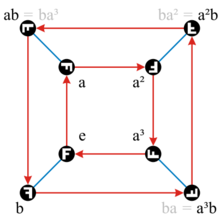
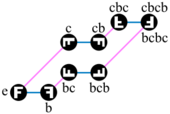
- A Cayley graph of the dihedral group on two generators and is depicted to the left. Red arrows represent composition with . Since is self-inverse, the blue lines, which represent composition with , are undirected. Therefore the graph is mixed: it has eight vertices, eight arrows, and four edges. The Cayley table of the group can be derived from the group presentation A different Cayley graph of is shown on the right. is still the horizontal reflection and is represented by blue lines, and is a diagonal reflection and is represented by pink lines. As both reflections are self-inverse the Cayley graph on the right is completely undirected. This graph corresponds to the presentation
- The Cayley graph of the free group on two generators and corresponding to the set is depicted at the top of the article, with being the identity. Travelling along an edge to the right represents right multiplication by while travelling along an edge upward corresponds to the multiplication by Since the free group has no relations, the Cayley graph has no cycles: it is the 4-regular infinite tree. It is a key ingredient in the proof of the Banach–Tarski paradox.
- More generally, the Bethe lattice or Cayley tree is the Cayley graph of the free group on generators. A presentation of a group by generators corresponds to a surjective homomorphism from the free group on generators to the group defining a map from the Cayley tree to the Cayley graph of . Interpreting graphs topologically as one-dimensional simplicial complexes, the simply connected infinte tree is the universal cover of the Cayley graph; and the kernel of the mapping is the fundamental group of the Cayley graph.
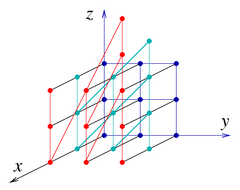
- A Cayley graph of the discrete Heisenberg group is depicted to the right. The generators used in the picture are the three matrices given by the three permutations of 1, 0, 0 for the entries . They satisfy the relations , which can also be understood from the picture. This is a non-commutative infinite group, and despite being a three-dimensional space, the Cayley graph has four-dimensional volume growth.[citation needed]
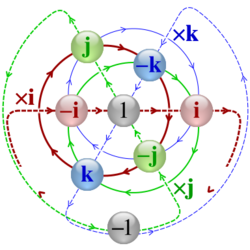
Characterization
The group acts on itself by left multiplication (see Cayley's theorem). This may be viewed as the action of on its Cayley graph. Explicitly, an element maps a vertex to the vertex The set of edges of the Cayley graph and their color is preserved by this action: the edge is mapped to the edge , both having color . In fact, all automorphisms of the colored directed graph are of this form, so that is isomorphic to the symmetry group of .[note 1][note 2]
The left multiplication action of a group on itself is simply transitive, in particular, Cayley graphs are vertex-transitive. The following is a kind of converse to this:
Sabidussi's Theorem — An (unlabeled and uncolored) directed graph is a Cayley graph of a group if and only if it admits a simply transitive action of by graph automorphisms (i.e., preserving the set of directed edges).[4]
To recover the group and the generating set from the unlabeled directed graph , select a vertex and label it by the identity element of the group. Then label each vertex of by the unique element of that maps to The set of generators of that yields as the Cayley graph is the set of labels of out-neighbors of . Since is uncolored, it might have more directed graph automorphisms than the left multiplication maps, for example group automorphisms of which permute .
Elementary properties
- The Cayley graph depends in an essential way on the choice of the set of generators. For example, if the generating set has elements then each vertex of the Cayley graph has incoming and outgoing directed edges. In the case of a symmetric generating set with elements, the Cayley graph is a regular directed graph of degree
- Cycles (or closed walks) in the Cayley graph indicate relations among the elements of In the more elaborate construction of the Cayley complex of a group, closed paths corresponding to relations are "filled in" by polygons. This means that the problem of constructing the Cayley graph of a given presentation is equivalent to solving the Word Problem for .[1]
- If is a surjective group homomorphism and the images of the elements of the generating set for are distinct, then it induces a covering of graphs where In particular, if a group has generators, all of order different from 2, and the set consists of these generators together with their inverses, then the Cayley graph is covered by the infinite regular tree of degree corresponding to the free group on the same set of generators.
- For any finite Cayley graph, considered as undirected, the vertex connectivity is at least equal to 2/3 of the degree of the graph. If the generating set is minimal (removal of any element and, if present, its inverse from the generating set leaves a set which is not generating), the vertex connectivity is equal to the degree. The edge connectivity is in all cases equal to the degree.[5]
- If is the left-regular representation with matrix form denoted , the adjacency matrix of is .
- Every group character of the group induces an eigenvector of the adjacency matrix of . The associated eigenvalue is which, when is Abelian, takes the form for integers In particular, the associated eigenvalue of the trivial character (the one sending every element to 1) is the degree of , that is, the order of . If is an Abelian group, there are exactly characters, determining all eigenvalues. The corresponding orthonormal basis of eigenvectors is given by It is interesting to note that this eigenbasis is independent of the generating set . More generally for symmetric generating sets, take a complete set of irreducible representations of and let with eigenvalue set . Then the set of eigenvalues of is exactly where eigenvalue appears with multiplicity for each occurrence of as an eigenvalue of
Schreier coset graph
If one instead takes the vertices to be right cosets of a fixed subgroup one obtains a related construction, the Schreier coset graph, which is at the basis of coset enumeration or the Todd–Coxeter process.
Connection to group theory
Knowledge about the structure of the group can be obtained by studying the adjacency matrix of the graph and in particular applying the theorems of spectral graph theory. Conversely, for symmetric generating sets, the spectral and representation theory of are directly tied together: take a complete set of irreducible representations of and let with eigenvalues . Then the set of eigenvalues of is exactly where eigenvalue appears with multiplicity for each occurrence of as an eigenvalue of
The genus of a group is the minimum genus for any Cayley graph of that group.[6]
Geometric group theory
For infinite groups, the coarse geometry of the Cayley graph is fundamental to geometric group theory. For a finitely generated group, this is independent of choice of finite set of generators, hence an intrinsic property of the group. This is only interesting for infinite groups: every finite group is coarsely equivalent to a point (or the trivial group), since one can choose as finite set of generators the entire group.
Formally, for a given choice of generators, one has the word metric (the natural distance on the Cayley graph), which determines a metric space. The coarse equivalence class of this space is an invariant of the group.
Expansion properties
When , the Cayley graph is -regular, so spectral techniques may be used to analyze the expansion properties of the graph. In particular for abelian groups, the eigenvalues of the Cayley graph are more easily computable and given by with top eigenvalue equal to , so we may use Cheeger's inequality to bound the edge expansion ratio using the spectral gap.
Representation theory can be used to construct such expanding Cayley graphs, in the form of Kazhdan property (T). The following statement holds:[7]
For example the group has property (T) and is generated by elementary matrices and this gives relatively explicit examples of expander graphs.
Integral classification
An integral graph is one whose eigenvalues are all integers. While the complete classification of integral graphs remains an open problem, the Cayley graphs of certain groups are always integral. Using previous characterizations of the spectrum of Cayley graphs, note that is integral iff the eigenvalues of are integral for every representation of .
Cayley integral simple group
A group is Cayley integral simple (CIS) if the connected Cayley graph is integral exactly when the symmetric generating set is the complement of a subgroup of . A result of Ahmady, Bell, and Mohar shows that all CIS groups are isomorphic to , or for primes .[8] It is important that actually generates the entire group in order for the Cayley graph to be connected. (If does not generate , the Cayley graph may still be integral, but the complement of is not necessarily a subgroup.)
In the example of , the symmetric generating sets (up to graph isomorphism) are
- : is a -cycle with eigenvalues
- : is with eigenvalues
The only subgroups of are the whole group and the trivial group, and the only symmetric generating set that produces an integral graph is the complement of the trivial group. Therefore must be a CIS group.
The proof of the complete CIS classification uses the fact that every subgroup and homomorphic image of a CIS group is also a CIS group.[8]
Cayley integral group
A slightly different notion is that of a Cayley integral group , in which every symmetric subset produces an integral graph . Note that no longer has to generate the entire group.
The complete list of Cayley integral groups is given by , and the dicyclic group of order , where and is the quaternion group.[8] The proof relies on two important properties of Cayley integral groups:
- Subgroups and homomorphic images of Cayley integral groups are also Cayley integral groups.
- A group is Cayley integral iff every connected Cayley graph of the group is also integral.
Normal and Eulerian generating sets
Given a general group , a subset is normal if is closed under conjugation by elements of (generalizing the notion of a normal subgroup), and is Eulerian if for every , the set of elements generating the cyclic group is also contained in . A 2019 result by Guo, Lytkina, Mazurov, and Revin proves that the Cayley graph is integral for any Eulerian normal subset , using purely representation theoretic techniques.[9]
The proof of this result is relatively short: given an Eulerian normal subset, select pairwise nonconjugate so that is the union of the conjugacy classes . Then using the characterization of the spectrum of a Cayley graph, one can show the eigenvalues of are given by taken over irreducible characters of . Each eigenvalue in this set must be an element of for a primitive root of unity (where must be divisible by the orders of each ). Because the eigenvalues are algebraic integers, to show they are integral it suffices to show that they are rational, and it suffices to show is fixed under any automorphism of . There must be some relatively prime to such that for all , and because is both Eulerian and normal, for some . Sending bijects conjugacy classes, so and have the same size and merely permutes terms in the sum for . Therefore is fixed for all automorphisms of , so is rational and thus integral.
Consequently, if is the alternating group and is a set of permutations given by , then the Cayley graph is integral. (This solved a previously open problem from the Kourovka Notebook.) In addition when is the symmetric group and is either the set of all transpositions or the set of transpositions involving a particular element, the Cayley graph is also integral.
History
Cayley graphs were first considered for finite groups by Arthur Cayley in 1878.[2] Max Dehn in his unpublished lectures on group theory from 1909–10 reintroduced Cayley graphs under the name Gruppenbild (group diagram), which led to the geometric group theory of today. His most important application was the solution of the word problem for the fundamental group of surfaces with genus ≥ 2, which is equivalent to the topological problem of deciding which closed curves on the surface contract to a point.[10]
See also
- Vertex-transitive graph
- Generating set of a group
- Lovász conjecture
- Cube-connected cycles
- Algebraic graph theory
- Cycle graph (algebra)
- ↑ Proof: Let be an arbitrary automorphism of the colored directed graph , and let be the image of the identity. We show that for all , by induction on the edge-distance of from . Assume . The automorphism takes any -colored edge to another -colored edge . Hence , and the induction proceeds. Since is connected, this shows for all .
- ↑ It is easy to modify into a simple graph (uncolored, undirected) whose symmetry group is isomorphic to : replace colored directed edges of with appropriate trees corresponding to the colors.
Notes
- ↑ 1.0 1.1 Magnus, Wilhelm; Karrass, Abraham; Solitar, Donald (2004). Combinatorial Group Theory: Presentations of Groups in Terms of Generators and Relations. Courier. ISBN 978-0-486-43830-6. https://books.google.com/books?id=1LW4s1RDRHQC&pg=PR2.
- ↑ 2.0 2.1 Cayley, Arthur (1878). "Desiderata and suggestions: No. 2. The Theory of groups: graphical representation". American Journal of Mathematics 1 (2): 174–6. doi:10.2307/2369306. https://babel.hathitrust.org/cgi/pt?id=uc1.$c239465;view=1up;seq=194. In his Collected Mathematical Papers 10: 403–405.
- ↑ Theron, Daniel Peter (1988), An extension of the concept of graphically regular representations, Ph.D. thesis, University of Wisconsin, Madison, p. 46.
- ↑ Sabidussi, Gert (October 1958). "On a class of fixed-point-free graphs". Proceedings of the American Mathematical Society 9 (5): 800–4. doi:10.1090/s0002-9939-1958-0097068-7.
- ↑ See Theorem 3.7 of Babai, László (1995). "27. Automorphism groups, isomorphism, reconstruction". in Graham, Ronald L.; Grötschel, Martin; Lovász, László. Handbook of Combinatorics. 1. Elsevier. pp. 1447–1540. ISBN 9780444823465. http://people.cs.uchicago.edu/~laci/handbook/handbookchapter27.pdf.
- ↑ White, Arthur T. (1972). "On the genus of a group". Transactions of the American Mathematical Society 173: 203–214. doi:10.1090/S0002-9947-1972-0317980-2.
- ↑ Proposition 1.12 in Lubotzky, Alexander (2012). "Expander graphs in pure and applied mathematics". Bulletin of the American Mathematical Society 49: 113–162. doi:10.1090/S0273-0979-2011-01359-3.
- ↑ 8.0 8.1 8.2 Ahmady, Azhvan; Bell, Jason; Mohar, Bojan (2014). "Integral Cayley graphs and groups". SIAM Journal on Discrete Mathematics 28 (2): 685–701. doi:10.1137/130925487.
- ↑ Guo, W.; Lytkina, D.V.; Mazurov, V.D.; Revin, D.O. (2019). "Integral Cayley graphs". Algebra and Logic 58 (4): 297–305. doi:10.1007/s10469-019-09550-2. https://link.springer.com/content/pdf/10.1007/s10469-019-09550-2.pdf.
- ↑ Dehn, Max (2012). Papers on Group Theory and Topology. Springer-Verlag. ISBN 978-1461291077. Translated from the German and with introductions and an appendix by John Stillwell, and with an appendix by Otto Schreier.
External links
 |
